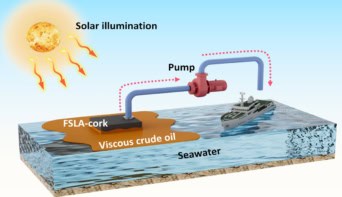Solar heat collectors can provide heat for a range of users – homes, offices, industrial processes – and to power cooling systems. Heat can also be stored for later use, while hybrid PVT systems offer the best of both worlds, power and heat, with heat extraction improving the performance of PV. Solar heat is already very widely used – globally it’s on a par with wind energy. PV is catching up fast, but solar heat also has a key role to play in the future, says Dave Elliott.
The UK may be doing reasonably well on green power, but it is not making much progress on green heat. What about solar heating? The familiar roof-top solar heat collector, with a flat glass plate on top of a box with pipework for cooling water, has been upgraded over the years to more efficient evacuated tube and focused solar and hybrid PV/thermal (PVT) variants. These systems can offer cost-effective no/low carbon heating in some locations and are mostly scalable, suitable for a range of small or large-scale applications. And you can store solar heat for use later and also use it to drive cooling systems. All in all, it’s an energy source with multiple attractions.
The UK Solar Trade Association (STA) says: “It’s time to look again at solar thermal. The strategic importance of this mature, proven technology is growing as our homes become more thermally efficient and require less space heating – we will continue to need hot water. The UK also needs to do much more to decarbonise heat, where we lag badly behind in Europe.”
STA’s Leonie Greene says: “One of the largest solar thermal schemes in the world, in Silkeborg, Denmark, provides a fifth of the heat for the district heating for a town of 43,000.” She adds, “Analysis by IRENA shows solar thermal could technically meet half of heat demand in the industrial sector. Indeed, half of industrial heat requirements are for medium to low temperatures, such as washing, drying, sterilizing and pasteurising. This makes solar thermal, which can do very hot process steam, well suited to sectors where heating needs are below 250 °C, such as paper, chemicals, tourism, pharmaceuticals and textiles. The farming industry also offers great opportunities.”
The UK’s Renewable Heat Incentive (RHI) provides support for solar thermal projects up to 200 kW, but more support is needed for a wider range and scale of projects if the full potential of solar heat is to be reached. The Energy Research Partnership’s report on decarbonizing heat, Transition to Low-carbon Heat, which I mentioned in an earlier post, says nearly half of the UK’s existing heat demand could be economically connected to green heat supply networks, up from 2% now, saving £30bn.
Solar heat, along with green gas, ought to play a part in that, with big solar arrays feeding heat stores and district heating networks. There are also many other options, including using solar heat for air con absorption chillers and along with heat inputs from heat pumps. High-temperature focused-solar, or concentrated solar power (CSP) sun-tracking systems can also be used for generating electricity on a large scale, but are best suited to sunny climates with direct (not diffuse) sunlight, and desert areas, for the large areas needed.
More relevant to the rest of us, there is also so-called PVT, hybrid solar thermal and PV systems, combining PV electricity production with heat absorption. That can improve the efficiency of PV cells, which falls off with temperature, as they heat up in the sun – PV works on light photons not infrared heat, so PV cells can get very hot.
In one approach to dealing with this problem, forced (powered) or passive (convection) air cooling flows may be used, with the warmed air being used for building heating. Alternatively, and more efficiently, water cooling is arranged in a heat collector substrate on the underside of a PV array, so that the pipework does not interfere with the incoming light. Some of the incident light will pass through to this heat collector, but as well as converting some to electricity, the PV cell material will block some of it, so that direct heat collection is reduced, over what it would have been with just a simple solar heat collector. The newer more translucent ink dye cell materials will reduce this effect but, in any case, the unconverted energy in the direct light blocked by the cell materials is in effect stored as heat, so it is still available for collection. As a result, in theory, with PV efficiency enhanced and overall heat collection efficiency not much reduced, a liquid cooled hybrid PV-T collector can generate up to 40% more energy than PV and solar-thermal panels installed side by side over the same area. Some clever new designs have emerged, some with evacuated tube systems to reduce heat loss.
Solar heating has obviously been somewhat eclipsed by solar PV in the UK and elsewhere, but these two solar options can complement each other via PVT, especially in hot climates for utility scale systems, including some with lens focusing (then competing with CSP), but also for domestic scale and building integrated units. For example, one recent review noted that “Building-integrated air PVT systems have the potential to reduce the primary energy required for heating and cooling from conventional systems by 30%, and in pre- heating applications where the fluid temperature is kept low, such as in combined PVT/heat-pump systems, the electrical output can be enhanced by 4–10% compared to an equivalent non-cooled PV system.”
Solar heating has been around for some while and continues to expand at around 12% p.a. PV is the relatively new kid on the block and is expanding faster – at around 45% pa. But it is worth noting that, globally, the use of solar heating is still more widespread than the use of PV solar, with over 465 GW(th) of rooftop solar thermal capacity in place (much of it in China), compared to only around 300 GW of PV so far globally. It is hard to predict exactly what will happen next but, although PV seems set to continue to accelerate rapidly, one of the big advantages with solar heat units is that you can store heat much more easily than you can store electricity. PV is getting cheaper, but we still need heat, and although some PV power might be used for heating (e.g. with excess daytime power run into an immersion heater), direct solar heating will continue to have a role, and PVT may become an important new option – in effect rooftop solar CHP. Pity it’s not supported in the RHI.
It’s perhaps worth noting that, whereas nearly all solar heat collectors in the UK are on rooftops, apart from some swimming pool schemes and the like, and so take up no extra land, PV solar is increasingly being put on the ground in large solar farms. About two-thirds of the UK’s PV projects are ground mounted.
With the cutbacks in FiTs for smaller domestic projects, and the block on CfD access, the trend to larger ground-mounted PV projects looks likely to increase. The STA has commented that “Government policy of excluding solar from clean power auctions is driving larger projects in a bid to get the economics to work.” Certainly some very large solar farm PV projects are planned, such as the ~350 MW array in Kent, covering 850 acres.
Is it a good idea to cover so much farm land with PV? In theory sheep can still graze on the site, but that seems rare in practice – most projects have security fences around them to keep people and animals out. Solar farms may be popular with farmers since some can no longer make enough money from food farming, but some prime farm land is being lost, with the only upside, apart from the power output, being that they may become a haven for wildlife and wildflowers, assuming the area isn’t sprayed to stop weeds and grasses from growing too high and blocking the sun. Well-sited arrays may not be a problem in visual terms, but the sheer scale of some PV projects can lead to opposition.
Obviously rooftop PV deployment is best (it’s then handily angled and also near to the energy user), the same for factory/warehouse roofs. However, there may then be contests for roof space with solar heat collectors! If we must go on-land with PV, then brown field/marginal land is surely preferable to prime farm land. That has been the government’s view, and for once they may be right. Though small community-owned projects may be an exception. But who knows what’s next re farming policy, post-Brexit and post the CAP. Meanwhile, rooftop solar heat collectors will hopefully continue to find roles in all sectors, reducing the need for the use of fossil fuels for heating and, in some locations, with large heat stores, offering summer heat for winter use.



